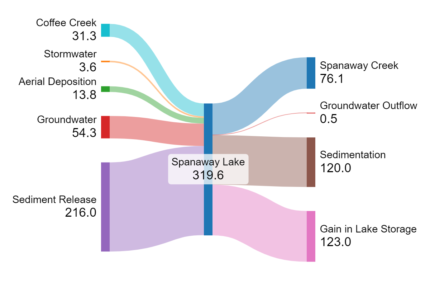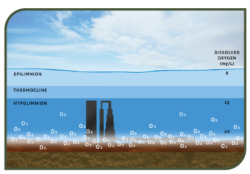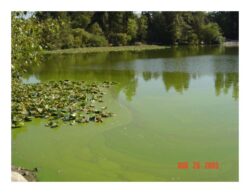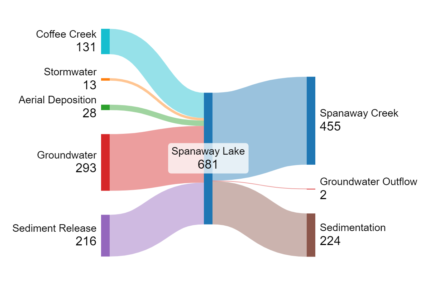By Katie Sweeney and Tim Clark, Herrera Environmental Consultants, Inc.
Spanaway Lake is a 251-acre lake in Pierce County that has long suffered from toxic algae blooms. Toxic blooms in Spanaway Lake are predominantly made up of two types of cyanobacteria, Microcystis and Dolichospermum, both of which produce the liver toxin microcystin. Since cyanotoxin monitoring began in 2007, microcystin concentrations have exceeded the state recreational guideline of 8 parts per billion (ppb) every year except 2012 and 2014, restricting lake uses and greatly impacting the lake community. It became clear to residents, visitors, and Pierce County managers that control of algae was necessary for the future protection and enjoyment of Spanaway Lake.
The Initial Plan
To understand the drivers of cyanobacteria and how best to prevent them in Spanaway Lake, Pierce County hired a team of consultants to collect data and develop a lake management plan (LMP) in 2016. Monitoring data from 2014 and 2015 showed that algae growth was primarily controlled by the amount of phosphorus in the lake and most of it (55 percent annually) was from sediment release due to hypolimnetic anoxia. To reduce phosphorus in the lake, the project team recommended a $2M hypolimnetic oxygenation system, like the Speece cone in Newman Lake, with an alum injector.
A Concerned Community
The Spanaway Lake community did not fully embrace the 2016 Plan and its implementation stalled. Questions were raised as to whether the recommended projects would adequately address the primary sources of phosphorus and if the analysis correctly identified those sources.
As the debate persisted about which treatment methods to pursue, confidence in the Plan waned. As a result, community consensus around any proposed solution was low. Consequently the plan was never implemented.
All the while, harmful algae impacts and concerns escalated. In response, community members advanced a petition urging the Pierce County Council to create a Lake Management District (LMD), and on September 21, 2021, Pierce County Council Ordinance 2021-84 was passed, establishing Spanaway Lake as the County’s first LMD. Today, the Pierce County Planning and Public Works Department operates the LMD in partnership with a Citizen Advisory Board, who make recommendations regarding lake improvement and maintenance, and provide annual workplan review. The workplan is reviewed and approved annually by the County Council.
With renewed community engagement and new financial support for alleviating toxic algae blooms, Pierce County sought to develop an updated strategy following the Lake Cyanobacteria Management Plan template provided by the Department of Ecology.
A New Hope
To address community concerns and develop an implementable Lake Cyanobacteria Management Plan (LCMP), Pierce County Planning and Public Works contracted with Herrera Environmental Consultants, Inc. (Herrera) in 2023. The new LCMP project evaluated data collected in 2014 – 2015 along with more recent lake water and sediment chemistry data from 2019, 2021, and 2023. With updated datasets and analyses, Herrera confirmed there are two major pathways of phosphorus to Spanaway Lake: (1) release from the lake’s anoxic sediments and (2) groundwater inflow.
- (1) Because of the debate concerning the magnitude of the internal load from the lake, Herrera used several methods to estimate the amount of sediment release. Even at the lowest estimated rate, internal phosphorus loading makes up approximately one-third of the annual load and two-thirds of the summer load.
- (2) Relatively large phosphorus loads from groundwater reflect the fact that most (around two-thirds) of the water enters the lake as groundwater. Modeling estimates that approximately one-sixth to two-thirds of the groundwater phosphorus load is related to leaching from on-site septic systems.
ANNUAL PHOSPHORUS LOADING
SUMMER PHOSPHORUS LOADING

These Sankey diagrams show the phosphorus budgets in kilogram and percent phosphorus load for Spanaway Lake on an annual basis (left; January–December) and on a summertime basis (right; May–October). In each diagram, phosphorus inputs to the lake are positioned on the left side, the total amount of phosphorus in the lake is in the middle (labeled as ‘Spanaway Lake’), and phosphorus sinks or outputs are on the right. The size of each input or output ‘flow’ is proportional to the amount of phosphorus each element contributes, removes, or stores. Internal sediment release and groundwater are the greatest sources of phosphorus to Spanaway Lake, with internal sediment release responsible for most of the phosphorus that is available to algae during the summer.
A plan is only a good plan if it can be implemented. As a lesson learned from the first Plan: No matter how scientifically sound or well-reasoned the proposed management method, implementation requires public support. Therefore, a key component of this updated lake management plan was expanded engagement with the community to better understand their goals and vision for Spanaway Lake. Herrera staff traveled to Spanaway Lake and spoke with community members three times during plan development to (1) identify community needs, (2) discuss findings and potential solutions, and (3) share the final recommendations for lake management.
Community concerns were specific to safety — specifically risks from contact with toxic algae blooms — and visual quality of the lake as impaired by algae scums (not necessarily toxic) and “muck” (organic material). The community highlighted a desire for near-term action to relieve the impact of cyanobacteria blooms while developing, designing, and permitting long-term solutions.
Giving Spanaway Lake a Breath of Fresh Air

An OST system distributes oxygen throughout the hypolimnion and lake sediment. Source: Natural Lake Biosciences
In agreement with the 2016 Plan, the new LCMP recommended a hypolimnetic oxygenation system as the best strategy for long-term algae control. Rather than a Speece cone with alum injection, the new plan recommended an oxygen saturation technology (OST) system. OST is the next generation of lake oxygenation, as a relatively new, patent-pending innovation used to administer precise concentrations of oxygen at strategic depths in a waterbody.
The system consists of an onshore facility and an in-lake device. The onshore facility generates and compresses approximately 95 percent pure oxygen. That oxygen is then transported to a chamber at the lake bottom where lake water is supersaturated with the oxygen. The oxygenated water is then injected back into deep areas of the lake where it disperses over the sediment surface and is continuously monitored to regulate performance. Because it is supersaturated, unlike traditional systems, the oxygenated water effectively penetrates the sediments, overcoming the high sediment oxygen demand and preventing the release of phosphorus from iron.
The Path Forward: Implementing the New Plan
Today, Herrera is working with Pierce County and the Spanaway Lake LMD to implement the new plan. First, lanthanum treatments in 2024 and 2025 to strip phosphorus from the water column will provide near-term relief from blooms while we work through the permitting and design process for installation of the OST system, which the County hopes to complete in 2026.
To learn more about cyanobacteria management in Spanaway Lake, read the Management Plan, or discover more about Spanaway Lake, visit the Management District website at https://www.piercecountywa.gov/7439/Spanaway-Lake-Management-District-No-1 and Friends of Spanaway Lake’s website at https://spanawaylake.org/. For more information about Herrera’s work protecting lakes and water resources in the Northwest, visit our website at https://www.herrerainc.com/ or contact Timothy Clark at tclark@herrerainc.com or 971-361-2238.












